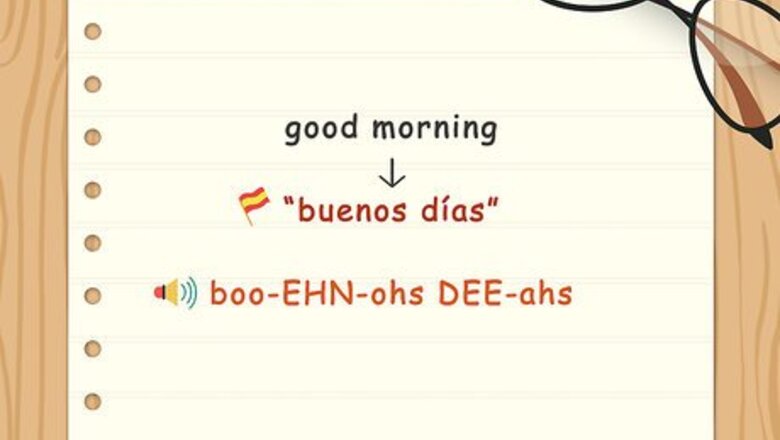
views
- Say buenos días (boo-EHN-ohs DEE-ahs) to wish someone a good morning in Spanish.
- To say “good morning” more casually in Spanish, use Buen día (“‘morning”), Buenas (“good day”) or ¿Qué tal tu mañana? (“how was your morning?”).
- To be more formal or polite, add a title like señor, señora, or señorita. For romantic situations, add a term of endearment like mi amor.
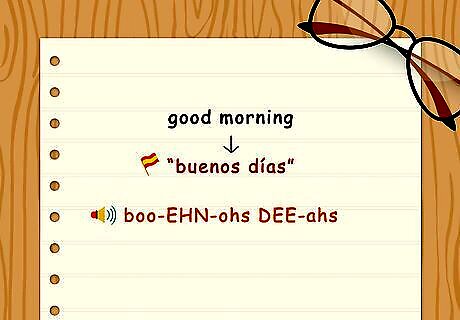
“Good morning” in Spanish is buenos días. This phrase is pronounced as boo-EHN-ohs DEE-ahs. When spoken quickly, however, a native English speaker may hear the pronunciation as BWEN-ohs DEE-ahs. Buenos días is a slightly formal phrase that has many similar alternatives. ¡Buenas! (boo-EHN-ahs): “Morning!” Used as a casual greeting throughout the day, but mostly in the morning. ¡Buen día! (boo-EHN DEE-ah): “Good day!” Used in informal, casual settings when talking to friends and peers. Buenos días a todos (boo-EH-nos DEE-ahs ah-TOE-dos): “Good morning, everyone.” Used more formally when greeting a large group of people, such as in a meeting or presentation. Buenos días, un placer conocerte (boo-EH-nos DEE-ash, oon-plah-ser koh-no-sehr-teh): “Good morning, nice to meet you.” Used in semi-formal settings when meeting someone for the first time.
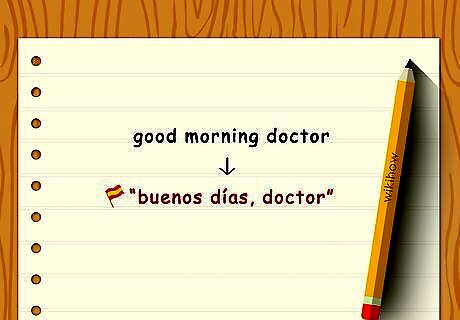
Follow your “good morning” with a specific title in Spanish. If you are speaking to someone in Spanish, it’s polite to follow up your “good morning” with señor, señora, or “señorita,” depending on who you’re addressing. This applies to formal situations, rather than with friends or peers. Buenos días, señora (boo-EH-nos DEE-ahs seh-NYOR-ah): “Good morning, ma’am.” Buenos días, señor. (boo-EH-nos DEE-ahs seh-NYOR): “Good morning, sir.” Buenos días, señorita (boo-EH-nos DEE-ahs seh-nyor-EE-tah): “Good morning, miss.” Buenos días, jovencita (boo-EH-nos DEE-ahs ho-vehn-SEE-tah): “Good morning, young lady.” Buenos días, jovencito (boo-EH-nos DEE-ahs ho-vehn-SEE-toe): “Good morning, young man.” Buenos días, señoras y señores (boo-EH-nos DEE-ahs seh-NYOR-ahs ee seh-NYOR-ehs): “Good morning, ladies and gentlemen.” Buenos días, maestro/maestra (boo-EH-nos DEE-ahs mah-EHS-troh/trah): “Good morning, teacher (male/female).” Buenos días, doctor (boo-EH-nos DEE-ahs DOHC-tore): “Good morning, doctor.”
Add a term of endearment for a romantic “good morning.” To say “good morning” in Spanish to your significant other, add a pet name like you would in English or your native language. Some common terms of endearment in Spanish include: Buenos días, mi amor (mee ah-MORE): “Good morning, my love.” Buenos días, hermosa (air-MOH-sa): “Good morning, beautiful.” Buenos días, guapo (goo-AH-poh): “Good morning, handsome.” Buenos días, princesa (preen-SEH-sah): “Good morning, princess.” Buenos días, corazón (core-ah-SOHN): “Good morning, my heart.” Buenos días, mi cielo (mee see-EY-loh): “Good morning, my darling.”
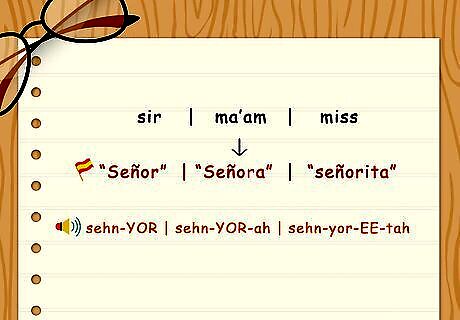
Greet people with the title that matches their gender. Spanish is a very gender-based language, so the titles you use will change depending on someone’s gender. Typically, terms addressing or describing males end with -e or -o, while terms addressing females end with -a. For an adjective like “guapo,” which means handsome or beautiful, use guapo for males and guapa for females. Gender-neutral terms are yet to be officially accepted by the official Spanish-language dictionary. However, native Spanish speakers in Latin America commonly use -e as the neutral ending for Spanish words. For example, you could replace the gendered title maestro (“male teacher”) or maestra (“female teacher”) with maestre.

Use another Spanish phrase for “good morning” based on the situation. These alternate ways to say “good morning” in Spanish are less formal than buenos días and may be used in more specific contexts. For example, use the commands ¡arriba! (ah-REE-bah) or ¡despierta! (des-pee-AIR-tah) to brusquely tell someone that it's time to get up. Levántate y brilla (leh-VAHN-tah-teh e BREE-yah): “Rise and shine!” Hora de levantarse (ORE-ah deh leh-vahn-TAHR-seh): “Time to get up!” Despierta, bella durmiente (des-pee-AIR-tah, BEH-yah door-me-EHN-teh): “Wake up, sleeping beauty.” ¿Listo para el día? (LEES-toe PAR-ah el DEE-ah): “Ready for the day?” ¡Ya amaneció! (ya ah-mah-neh-see-OH): “The sun’s already up!” ¿Cómo amaneciste? (KOH-mo ah-mah-neh-SEES-teh): “How did you wake up?” ¿Cómo dormiste? (KOH-mo door-MEES-teh): “How did you sleep?” ¿Dormiste bien? (dore-MEES-teh bee-EHN): “Did you sleep well?” ¿Descansaste? (dehs-can-SAHS-teh): “Did you get a good rest?” ¿Soñaste con los angelitos? (soh-NYAH-stay cone loh-s ahn-heh-LEE-toes): “Did you dream with the little angels?” ¿Qué tal va tu mañana? (keh tal vah too mah-NYAH-nah): “How’s your morning going so far?” Que tengas una bonita mañana (keh TEHN-gas OO-nah boh-NEE-tah mah-NYAH-nah): “Have a nice morning.” ¡Qué hermosa la mañana! (keh air-MO-sah la mah-NYAH-na): “What a beautiful morning!” Saludos (sah-LOO-dos): “Greetings.” Hola, ¿cómo estás? (OH-lah KOH-moe es-TAHS): “Hi, how are you?” ¿Qué hay de nuevo? (kay eye day noo-EY-voh): “What’s new?” ¡Qué tengas un buen día! (keh TEN-gahs oon boo-EHN DEE-ah): “Have a nice day!”













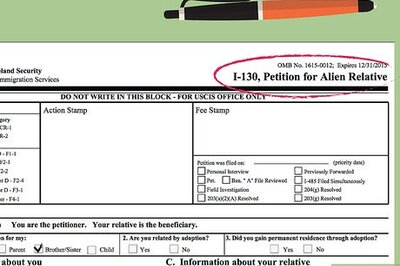



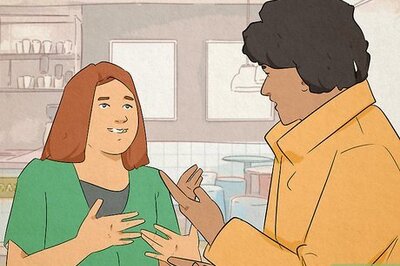


Comments
0 comment